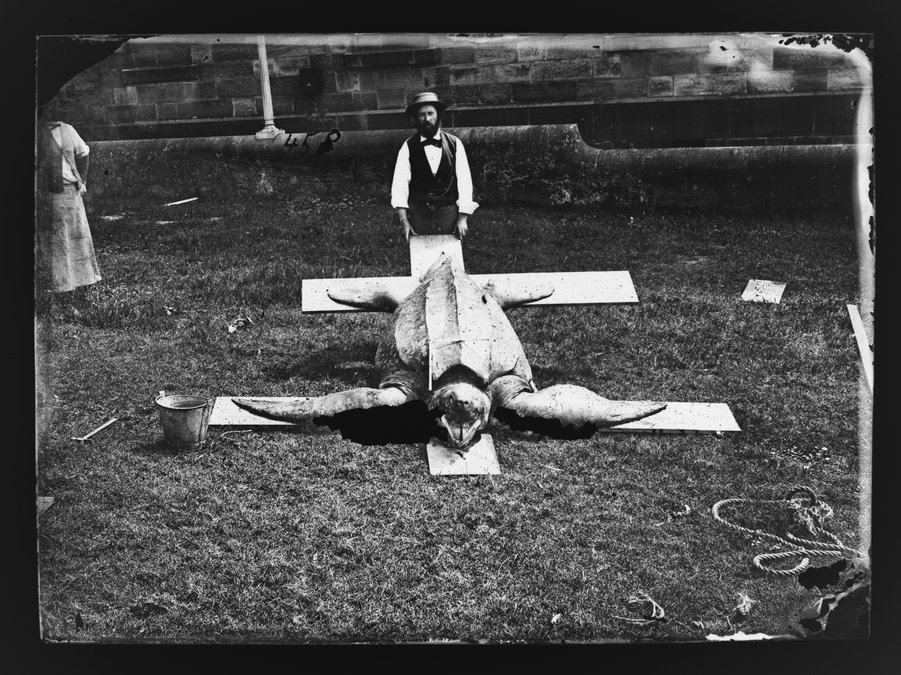Glass plate negatives
The glass plates are the archives’ oldest photographic collection, with the first plates dating from the mid 1860s.

The V Negative Collection
The glass plates at the Australian Museum are known as the V Negative Collection. The series contains more than 10,000 plates of varying sizes; most of the earliest plates are ‘full-plate’, measuring 6 & 1/2 x 8 & 1/2 inches (165 x 216 millimetres).
The last glass plates in the collection were taken as late as the 1940s. Because they are so large, the plates are generally crisp and clear; once digitised and enlarged (either by carefully scanning on a flatbed scanner or with the use of an overhead camera and lightbox), they can reveal not just background information but also wonderful detail of texture and tone.
Unfortunately, before 1893, none of the glass plates were dated, indexed or registered at the time they were taken, and so parts of the history of the making of the collection have been lost. Although albums of prints made from the plates were created from the mid-1870s, it was not until almost twenty years later that the first 1500 glass plates were listed by number, title and photographer. By then, knowledge of the content of some of the images had already been lost and there are some early images for which the Museum has no information at all – no title, no date and no photographer. Even after the Museum’s photography began to be more systematically managed, registration was not necessarily in chronological order and often happened many years after the images were taken. Registration at the time of creation did not begin until 1906, by which stage the collection already held 2500 photographs.
So far it has been impossible to be definitive in dating the earliest Museum image. It has taken the dedicated work of archivists, researchers and collection managers to establish confirmed dates for just a selection of images.
Australian Museum's earliest glass plate photographers
Three very different men became the Museum’s first photographic image makers. Although none would have regarded himself as a professional ‘photographer’, each was a trained observer of the natural world, and each had his own practical skills and experience to bring to the new technique and its tools. Of the three, it was Henry Barnes, the Museum’s taxidermist and articulator (the process of cleaning and assembling an animal skeleton), who most often set up the specimens for photography, operated the camera, developed the glass plates and made the photographic prints. Curators Gerard Krefft (Curator 1864- 1874) and Edward Ramsay (Curator 1874 - 1894) directed operations, stage managed the production, and made use of the products.
Alongside the Museum’s documentary project, each of these key players sometimes had their own personal goals in mind and in eye as they learnt (mostly by trial and error) to make the most of the cameras, plates, basins, chemicals and papers – as well as the thousands of images they produced over these early decades of Museum photography.
Although they may not always have got on (it seems that Krefft was particularly difficult to work with), Krefft, Barnes and Ramsay each made an important contribution to the practice, aesthetics and purpose of Museum photography.
Unlike a hand-drawn illustration, which is usually signed by its maker, scientific photography can sometimes appear more ‘objective’ and mechanical than it really is. But like the specimens that make up a natural history museum’s collection, these photographs are deliberately and carefully made and used. The Australian Museum is fortunate to have the oldest, largest and most intact documentary archives of any museum in Australia. This unusually rich resource – including administrative records, reports, account books, building plans and of course the photographs themselves – means that it is still possible to not only reconstruct the stories of individual images, but also uncover the stories of the men behind the images.
Over the years still more photographic collections on glass plates were acquired from independent sources. These came to the Museum through donations, purchases and exchanges among the Museum's local and international networks, but especially locally from donors and amateur photographers in Sydney and New South Wales. These include glass plate collections of George Brown, Thomas Dick, Frank Hurley, Walter Roth, Percy Money, Henry (Harry) James Burrel, Michael Sharland and Anthony Musgrave.
See more photographic collections
Dive into the Australian Museum photographic collections and learn about the Museum's rich history through rarely seen photos.
Discover more

![AMS351/V01223 Dromaius novae hollandiae [Emu] (lateral view)](https://media.australian.museum/media/dd/images/AMS351_V1223.8f594fd.7a37947_copy.e347eca.width-600.2292a3c.jpg)














